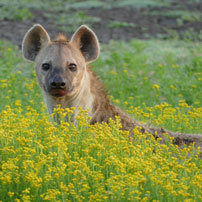 Departing Lusaka in the early morning it was a two and three quarter hour flight, by comfortable Cessna 206, to the small town of Kalabo in western Zambia, gateway to a place I had been wanting to visit for several years – the Liuwa Plains.
Departing Lusaka in the early morning it was a two and three quarter hour flight, by comfortable Cessna 206, to the small town of Kalabo in western Zambia, gateway to a place I had been wanting to visit for several years – the Liuwa Plains.
The plains cover a vast area – approx 3660 sq.kms., and were originally the hunting grounds of the king of the Lozi people. The plains were designated National Park status in late 1980’s, however poaching and neglect meant that game levels were generally low. By 2005 conservation was being taken seriously and in 2012 the management of the park was taken over by African Parks (a non-profit organisation that specialises in rehabilitating and running African safari parks) and so began the park’s journey back to health. The Zambian Carnivore Program also formed a base in the park and have been working closely with African Parks ever since.
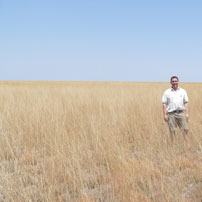
As we left Kalabo and bumped across the plains in the early afternoon heat, I wondered whether this trip would live up to the hype. Remote parks that not many people visit are often talked up a little too much. I knew to expect a vast openness, a remote feel, plenty of bird life and if I was lucky some more ‘traditional’ game-viewing. I also knew that I had four days to explore the park – an utterly luxurious schedule that I am not used to, but which turned out to be completely sensible.
The park is principally known for four things. Firstly, the vast open tree-less landscape that draws the breath and invokes a serenity that only genuine space and quiet can create. The remote location and exclusive nature of the park also add to its ‘allure’.
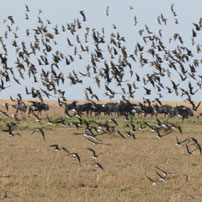
Secondly, Africa’s second largest wildebeest migration (after the Serengeti/Mara) as approximately 25,000 blue wildebeest migrate seasonally between the northern and southern reaches of the park (as well as outside the park to the north into Angola too).
Thirdly, for birding. Rare species such as rosy-throated long claw, palmnut vulture, wattled cranes, lesser jacana and purple heron are found here. However it is not just the birding ‘ticks’ that enthusiasts come for, as the sheer numbers of certain species are incredible. Storks and cranes gather around the water holes in large numbers, whist red-winged pratincole put on wonderful displays throughout the year.
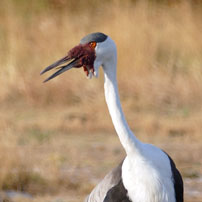
Lastly, a legendary lioness known as Lady Liuwa, who (for an unknown reason) became the only remaining lion in the park and survived alone for several years before African Parks were able to introduce further lions. Known as ‘Mambeti’ by the local people, Lady Liuwa is held in high esteem. The story goes that before Liuwa Plains became a national park the Lozi king had a spiritual governor who oversaw the management of the hunting grounds for him. This man, called Sienge, was rumoured to be able to influence the behaviour of lions and was held in great reverence by the local people. When his daughter Mambeti died, she was buried in the heart of the hunting grounds. Years later when the lions in the park mysteriously disappeared and Lady Liuwa was left all alone, she used to visit Mambeti’s grave regularly, for significant periods of time, as if seeking comfort and company. As the Lozi believe that after death they are re-incarnated as a lion, it is believed that Lady Liuwa carries the spirit of Mambeti.
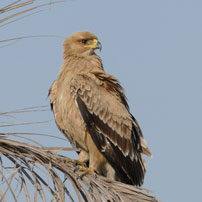
The apex predator on the plains is currently the spotted hyaena, though lion are gaining slowly in numbers, cheetah populations are in good health, and it is hoped the two wild dog packs that roamed the park in 2014 will return soon. The key prey species are the wildebeest herds, though the park is also home to zebra, buffalo (re-introduced by African Parks), tsessebe, red lechwe, eland and the relatively rare oribi. There are no impala, bushbuck or puku, so leopard might struggle and are not currently found in the park. During my four day visit I saw many spotted hyaena, including youngsters at a den site, spent a magical morning with a mother cheetah and her two cubs, and came across two lionesses out on the plains who then came through our camp that night. Early one morning we spotted an African wild cat, on a night drive we had a lovely serval sighting (caracal are also found here) and we also saw several side-striped jackals. Every single sighting was for our small group alone, from start to finish. In four days we barely saw another vehicle.
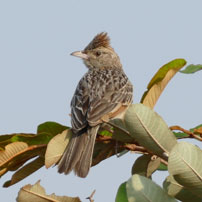
As my visit was in early November, the rains were yet to fully break (after a long dry season) so the wildebeest migration down from the northern reaches of the park had not yet quite began (the wildebeest migrate between the north and south according to food and water availability, usually spending November to June in the south and the drier July to October period in the north).
On our third day in the park we set off on a full day safari to explore the park and try and catch up with the herds. It was the most unbelievable day! We drove north-west, east and then south again, through continually changing (but always flat!) habitats. The entire day involved around 10 hours driving, and at least 7 hours of these were ‘off road’. Our guide Innocent knows his way around and we moved freely from one water pool or lagoon to the next, one minute driving through swaying waist high golden grass, the next across sun scorched sands. Where rain had fallen a week or so earlier the plains shimmered a vibrant green, whilst in places, pockets of woodland broke the horizon and provided a different landscape to explore. Many of the ‘pools’ in the park are currently dry, but where water can still be found we witnessed the essence of Liuwa – hyaena’s cooling off in the shallow water, wildebeest and zebra arriving in long lines to drink and a myriad of bird life on show around the fringes – fish eagles, storks, cranes, herons, pelicans, ducks, geese, plovers – the list goes on! Most memorable for me however where the vast flocks of red-winged pratincole which were just incredible to watch.
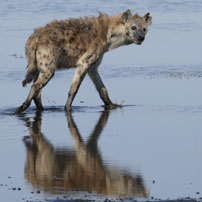
Whilst we saw plenty of wildebeest, the day was ironically not long enough for us to find the core migration herds. Sporadic rains at this time meant they were moving around a lot in the north, following the scent of rain, but were not quite ready to move south on their traditional route. I would guess that a week or two later (the humidity was rising and the main rains would have arrived shortly after my visit!) the herds will have filled the horizon.
The following morning we undertook a walk across the plains. Exploring on foot always offers a different experience and the wildlife reacts accordingly. We watched bemused as oribi two hundred metres from us panicked and bounded off impressively. Wildebeest snorted our passing and the normally over confident hyaena kept their distance. We saw fresh lion spoor, two daughters who hang around together, but did not see them. Unlike some regions, it is clear that the lions cover large distances in search of food. We ended the walk at a beautiful pool that was still nicely full of water, only to have our cup of tea interrupted by a hyaena charging through a flock of marabou storks with half a wildebeest calf in its jaws. The blood drenched hyaena splashed straight into the water to cool down, before being mobbed by the jealous maribou. As vultures began to land I reflected on how ‘unscripted’ and wild the Liuwa Plains are.
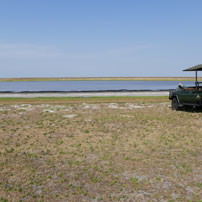
In fact having reached the end of my four night visit, I could conclude that Liuwa was indeed a very special place. The expense and effort of getting here will not suit everybody (though flight prices should be coming down from 2017) but for those that do make it here, a genuinely great African adventure awaits. Driving across the plains there were many moments when I was reminded of the Serengeti, and of the Kalahari too. When the wet season sets in, the scene could be reminiscent of certain patches of the Okavango Delta. Roll it all together and you have a vast tract of beautiful wilderness that offers exclusivity and escapism above all else. If you have never been to Africa before then it will just be a beautiful park to visit, one of many perhaps, but without elephants, giraffes or hippo. It is not really a ‘first safari’ destination. But for those who have travelled the continent and enjoyed several safaris, Liuwa offers something wonderfully different and intriguing. It could touch your sole.
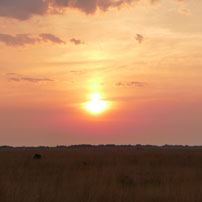 I have made a short film of my visit which can be viewed via the following link – The Magical Liuwa Plains.
I have made a short film of my visit which can be viewed via the following link – The Magical Liuwa Plains.
FACT FILE – Liuwa Plains National Park
Mammals
- Approx 25,000 blue wildebeest
- Zebra (Upper Zambezi)
- Oribi
- Steenbok
- Common duiker
- Reedbuck
- Tsessebe
- Red Lechwe (December to June during flood season only)
- Eland
- Cape buffalo (about 100 now, 45 reintroduced originally)
- Lion – currently 6 (Lady Liuwa, 1 female, 3 cubs, 1 new male import)
- Hyaena (spotted) – dominant predator due to large numbers
- Cheetah – around 15 or 20 in park and extended area to the north – 8 are collared
- Wild dogs – not seen by Carnivore project since 2014 but reports of their existence from time to time from villagers
- Serval
- Side-striped jackal
- Banded mongoose
- African wild cat
- Caracal
- Zorilla
Birds (just a small selection)
- African fish eagle
- Crowned cranes
- Wattled cranes
- Denhams bustard
- Secretary bird
- Bateleur eagle
- Martial eagle
- Melodious lark
- Purple heron
- Red-winged pratincole – large flocks November to May/June only
- Marsh harrier
- Black-chested snake eagle
- Plum-coloured starlings
- Rosy-throated long claw
- Palmnut vulture
- White headed vulture
- Lesser jacana
- Pygmy geese
- Paradise flycatcher
Access
Currently, limited scheduled flights from Lusaka land at Kalabo town, from where it is a 2.5 hour road transfer into the park. Mantamanene airstrip inside the park could be available for use at some stage in the future.
Seasons
Jan to March – rainy season and very flooded but still areas of dry land. Access and moving around be vehicle very limited, so not currently possible to visit at this time. Wildebeest in southern area and bird life amazing especially water birds.
April to June – still green after rains with pools holding water and rivers gently flowing before drying up as the season progresses. Wildebeest stay in south until burning in the north promises fresh grazing (the grass shoots appear after burning because the soils retain water after the rains). At some stage in late May or June the wildebeest head north again with only the territorial males staying behind. Some hyaena and cats follow the herds, and day trips to north become necessary in order to witness the big herds.
July to October – the dry season where pools and waterways dry up. Some permanent pools in the north and pools in the south will last depending on the previous rains and the water table. In a very dry year all pools in south will dry up by August, whilst in a wetter cycle some pools will hold water through to November. Wildebeest in north during this period so day trips definitely needed. Cats also mainly in north, especially cheetah. Birding okay but less so for water birds in south.
November/December – arguably a prime time to visit, especially late November, early December. The rains begin in November, which brings the wildebeest herds down from the north as the southern pools fill up and hold water again. However, November is a transition month so later in the month is much more guaranteed for seeing the herds in the south. The wildebeest calve in early November prior to coming south, as the hyaena populations are strong in the south so the young wildebeest need to be strong enough to survive. The southern landscape could be bone dry, brown, grey and yellow in early November, and then a beautiful vibrant green with flowers by early December. Birding is really good especially once pools fill up, and the predators around permanently once herds arrive.
Best times to visit are in late November, December, April, May and early June. Rainfall is hardest in January and February, but rain can fall anytime between late October and early April.
Accommodation
There is only one permanent tourism camp in the park, a luxury camp called ‘Mambeti’ which opened April 2017 to replace the previous Mantamanene Camp. Mambeti will be open from April to July and then from October to December, though eventually they hope to open year round with a mobile camp set up in the northern section of the park from June to November.
